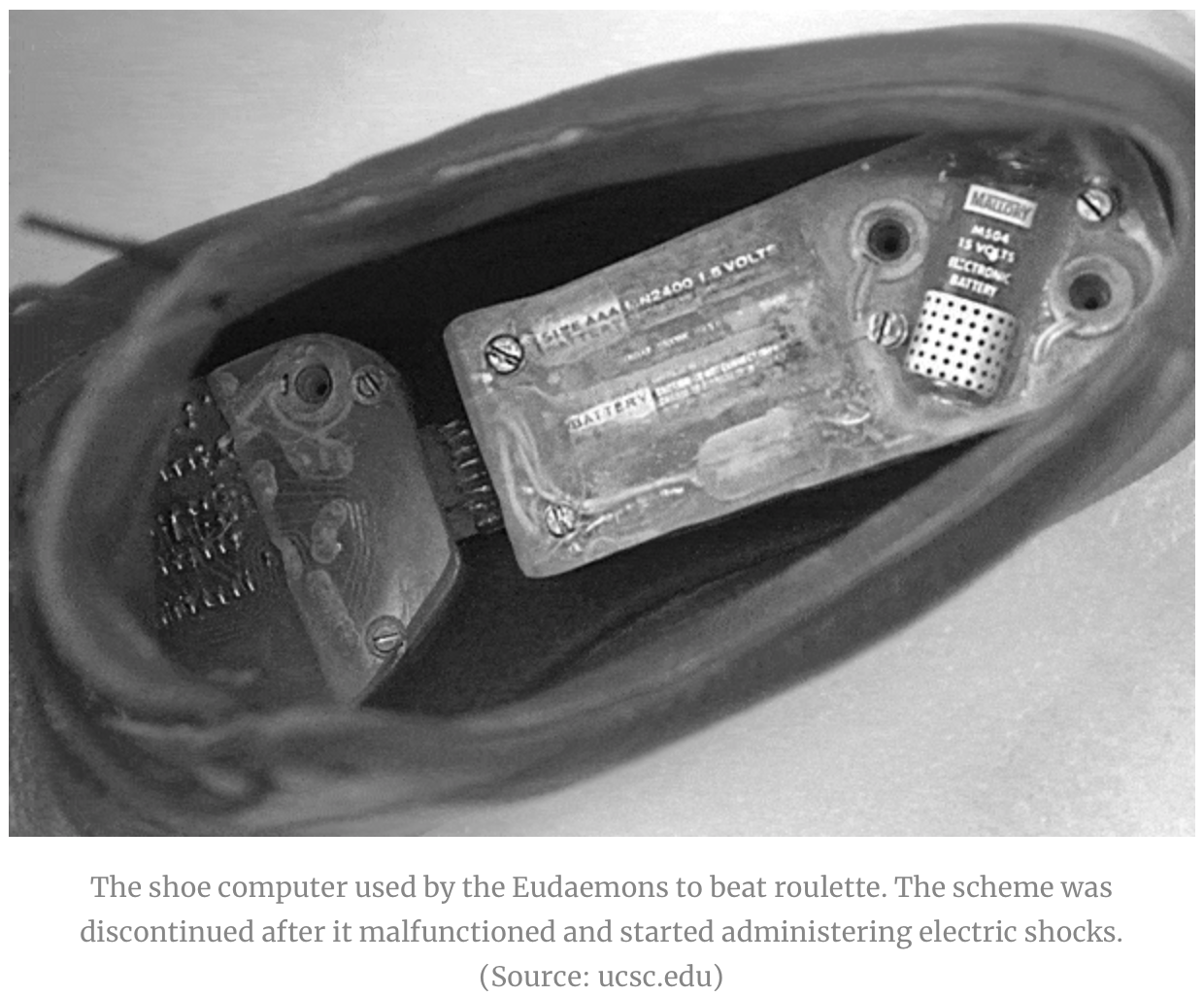Roulette Shoe


Practice it works in
The roulette shoe was created in the late 1970s by a group of students at the University of California, who called themselves “The Eudaemons”, to help players win at roulette. To avoid potential problems with the casino authorities, they decided that the sole of the a shoe was the least conspicuous location for their creation.
Its specific use
The roulette shoe is basically a computer within a shoe. The Eudaemons made use of two separate shoe computers – one worn by the observer and the other by his accomplice. The first, shown in the drawing above, used a MOS Technology 6502 microprocessor and was worn by an observer near the roulette wheel. The observer would clock the motion of the wheel and ball using a toe-operated switch.
A prediction of where the ball would land on the wheel would be generated by the observer’s shoe computer and immediately transmitted to an accomplice. The accomplice would then feel a unique pattern and frequency of buzzing solenoids in their shoe. This would tell which octant of the roulette wheel was most likely to catch the ball and they can place their bets according to this information.
Mobility
Due to its small size and portability, the computer was very convenient and could be transferred from one shoe to another with ease.
Utility vs Fashionability
The roulette shoe’s casing was made of epoxy, a material that could keep out moisture and was strong enough to create a platform that could survive the pressure of being walked upon. In addition, a separate section called the “battery boat” was built to house the batteries and was designed to be easily disconnected so that fresh batteries could be installed quickly. While the shoe had its pros, it also led to some problems. After one of the computers malfunctioned, a member suffered from electronic shocks which resulted in burns. Since then, they ceased usage of the roulette shoe.
Since the computer was meant to be hidden in a shoe, very little detail was given to its aesthetic design. It was simply wires and electronics encased in transparent container so that its user had full visibility.
UA Gemini 3 Record-Equipped Smart Shoes


Practice it works in
These Under Armour smart shoes was made for runners who want to track their running, walking or jogging data without having to wear an extra accessory like a smartwatch or fitness band.
Its specific use
Apart from recording time, distance and pace, these smart shoes can also measure muscular fatigue and lets the user know if he is ready for a run. The user has to jump 6 times, and the sensors and microchip embedded inside the shoes will allow the prediction of fatigue over time based on the user’s jump score. Simply put, the user can get a better idea of whether he is in good enough shape for putting in a big run.
Furthermore, the sensor inside the shoe records the users’ fitness data uses bluetooth connectivity to sync the data with the UA MapMyRun app, allowing the user to track his progress over time.
Mobility
Since the technology is all encapsulated within the shoe itself, this reduces the hassle of wearing an extra fitness accessory. All the user has to do is put on the shoes, and he’s good to go! Since the shoes are lightweight as well, it’s highly mobile.
Utility vs Fashionability
Apart from the smart technology, the shoes also have innovative UA SpeedForm® construction moulds to the foot for a precision fit. The engineered mesh used on the tongue and toe box also enhances fit and increases ventilation. Its internal heel counter also provides seamless, lightweight support and structure.
The shoes also come in 3 different designs, making it both highly functional and fashionable at the same time.
